Table of Contents
- Introduction
- Editor’s Choice
- Global Adoption of Virtual Assistants
- Global Virtual Digital Assistant (VDA) Market Size
- Industries Utilizing Virtual Assistants
- Consumer Adoption and Preferences
- Demographic Analysis of Virtual Assistant Users
- Major Virtual Assistant Players
- Virtual Assistants Employment Statistics
Introduction
According to Virtual Assistant Statistics, Virtual assistants (VA) are an AI-powered software application designed to simulate human interaction and assist users in completing tasks, answering questions, and providing information or services.
Virtual assistants leverage technologies such as natural language processing (NLP), speech recognition, and machine learning to understand and respond to user inputs, whether typed or spoken. Virtual assistants continue to evolve, becoming more sophisticated and integrated into various aspects of our lives. Their convenience and functionality make them a prominent part of the modern technology landscape.
Editor’s Choice
- Intelligent Virtual Assistant Market was valued at USD 7.43 Billion
- By employing a virtual assistant, businesses can achieve a cost reduction of 78%.
- Predictions suggest that virtual professionals will make up 50% of the US workforce by 2028.
- Among individuals aged 18 to 29, 28% actively employ virtual assistants, showcasing their prevalence among younger demographics.
- Virtual assistants earn between $2 and $20 per hour.
- Hourly wages are the compensation method for 87% of virtual assistants.
- The expense of virtual assistants is 78% lower than that of full-time, in-person employees.
- In the United States, the typical age of a virtual assistant is 40.
- A virtual assistant is utilized by 35% of well-paid executives.
Global Adoption of Virtual Assistants
- Once confined to the realm of science fiction, virtual assistants have seamlessly integrated into billions of devices across the globe. The year 2026 is expected to witness a staggering presence of over 150 million voice assistants in the United States.
- Anticipating an expansive trajectory, the global installed base will surpass 27 billion units by 2028.
Global Virtual Digital Assistant (VDA) Market Size
- The revenue generated by virtual digital assistants has experienced a remarkable growth trajectory over the years. In 2015, the revenue stood at $1,640 million; by 2016, it witnessed a moderate increase to $1,939.40 million.
- The year 2020 saw a further surge, with revenue reaching $12,120.90 million, while 2021 witnessed a notable increase to $15,792.60 million.
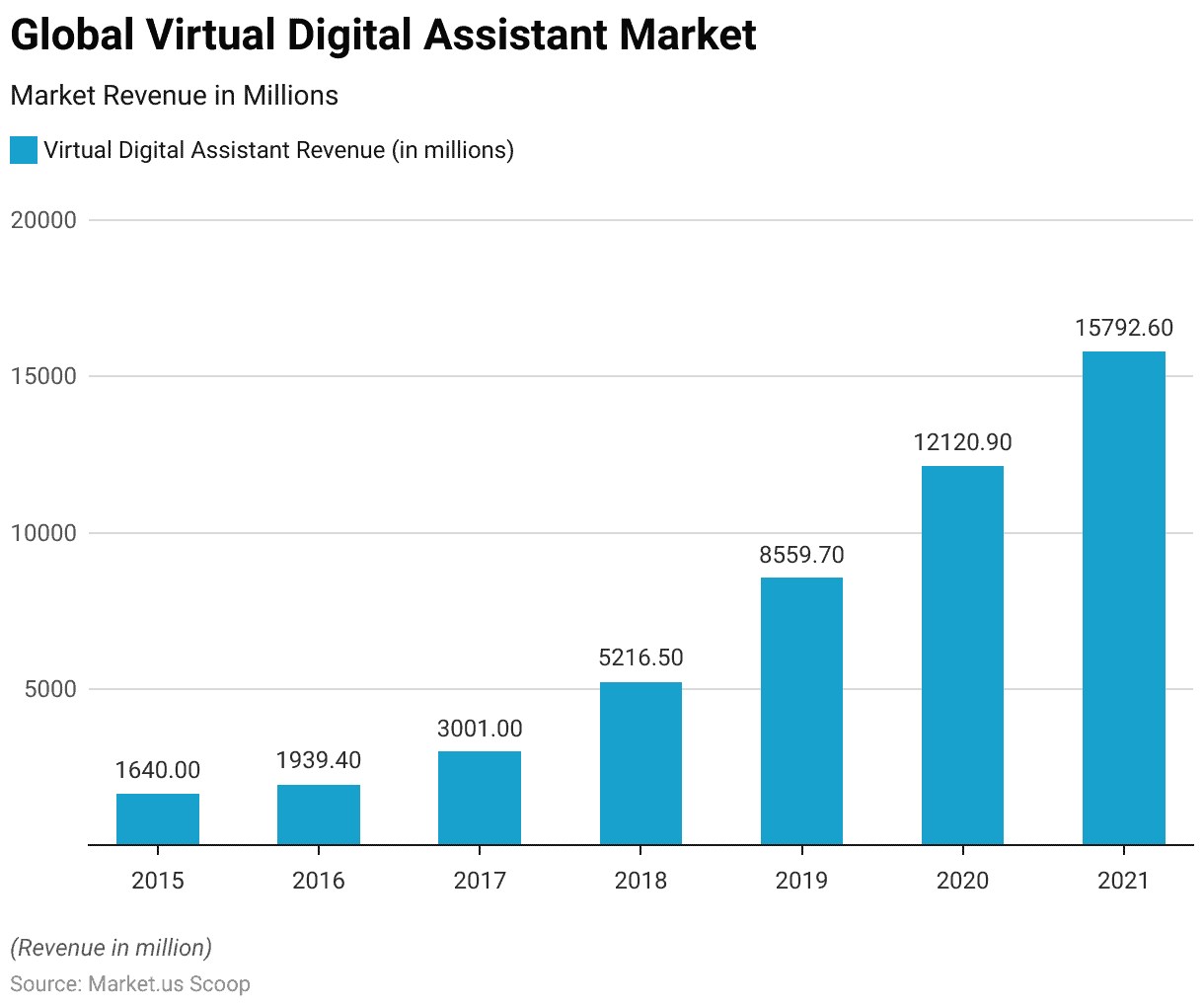
Industries Utilizing Virtual Assistants
- Virtual assistants have gained significant traction across diverse sectors, with varying degrees of utilization. They play a central role in administrative work, being adopted by 37.7% of businesses.
- Their application extends to marketing, where they contribute to streamlined operations for 20.5% of entities.
- In sales and prospecting activities, these digital aids are employed by 14%, facilitating more efficient processes.
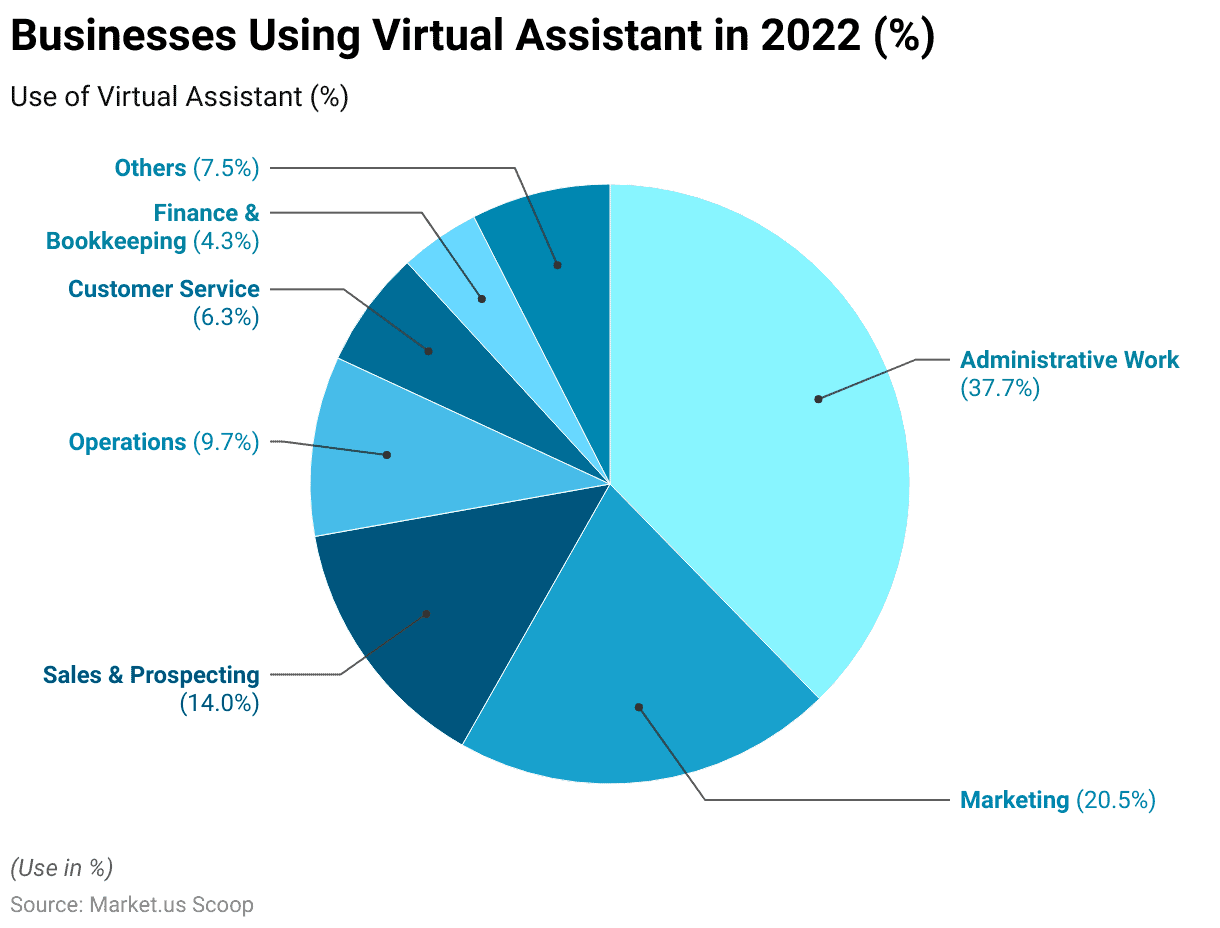
Consumer Adoption and Preferences
- In a survey conducted by PwC involving 1,000 individuals aged between 18 and 64 in the United States, 10% of respondents were unfamiliar with voice-enabled devices and products.
- Among the remaining 90% who were acquainted with such technology, the predominant segment (72%) had engaged with a voice assistant.
- The impetus behind this adoption is attributed to younger consumers, households with children, and those with an annual income exceeding $100,000.
- Despite the ubiquitous accessibility of voice assistants, 74% of consumers use their mobile voice assistants primarily within their homes. Feedback from the majority of participants in focus groups emphasized a privacy preference when interacting with their voice assistants and expressed reservations about using them in public due to perceived social awkwardness.
- This inclination could elucidate the lower usage of voice assistants among individuals aged 18 to 24, given their propensity to spend more time outside their residences.
Adoption of Virtual Assistants in Home
- Virtual assistants have established a significant presence in home equipment, as survey responses indicate their adoption across various categories. Notably, 58% of respondents reported utilizing virtual assistants with televisions, showcasing their integration into entertainment systems.
- Lighting control follows closely, with 36% of participants employing virtual assistants to manage lights, highlighting their role in enhancing home ambiance.
- Regarding environmental control, 29% of respondents utilize virtual assistants for regulating thermostats, contributing to energy efficiency.
- Additionally, 26% have integrated virtual assistants into alarm systems for enhanced security measures.
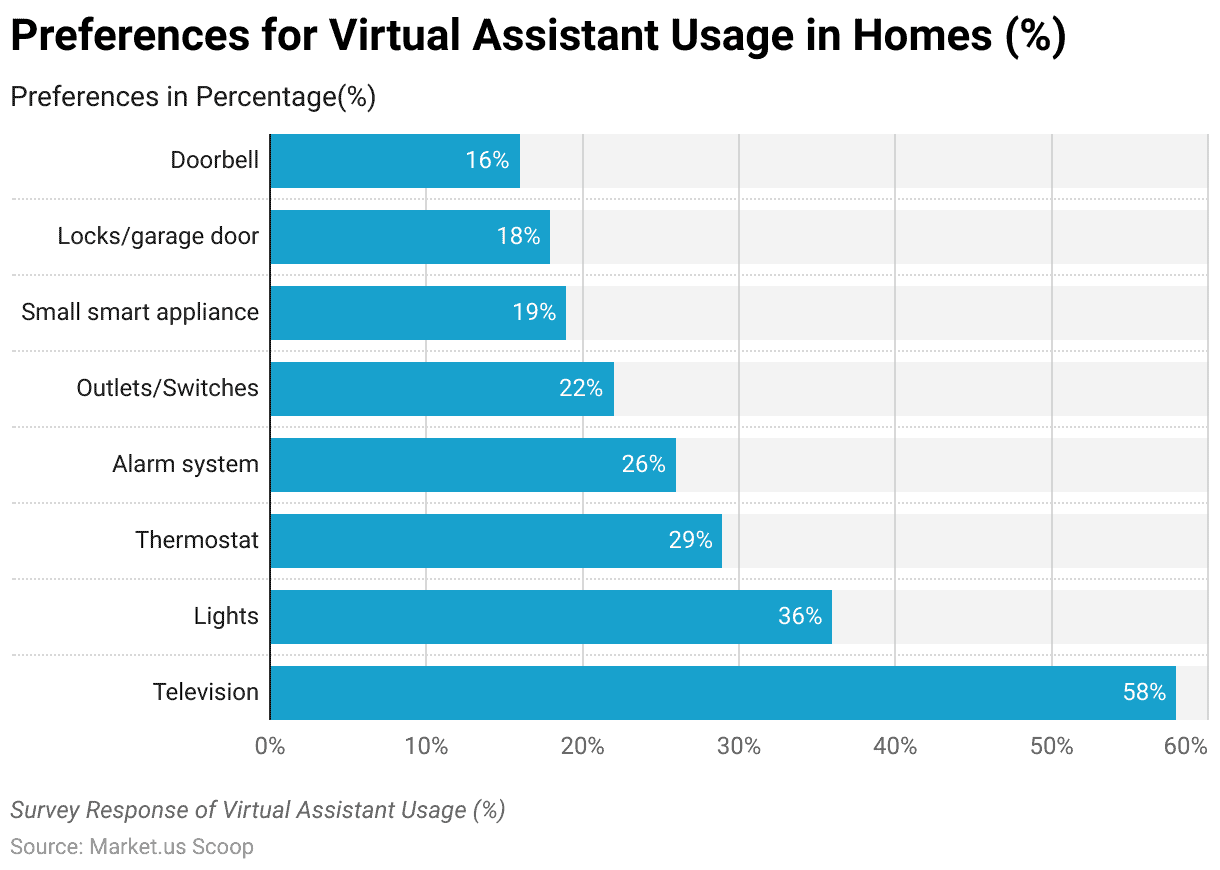
Demographic Analysis of Virtual Assistant Users
According to Gender
- Utilizing virtual assistants demonstrates a balanced gender distribution, as survey responses indicate. Among the respondents, 51% identify as female, while the remaining 49% identify as male.
- This parity in virtual assistant usage across genders underscores their widespread adoption and integration into daily routines, transcending gender boundaries.
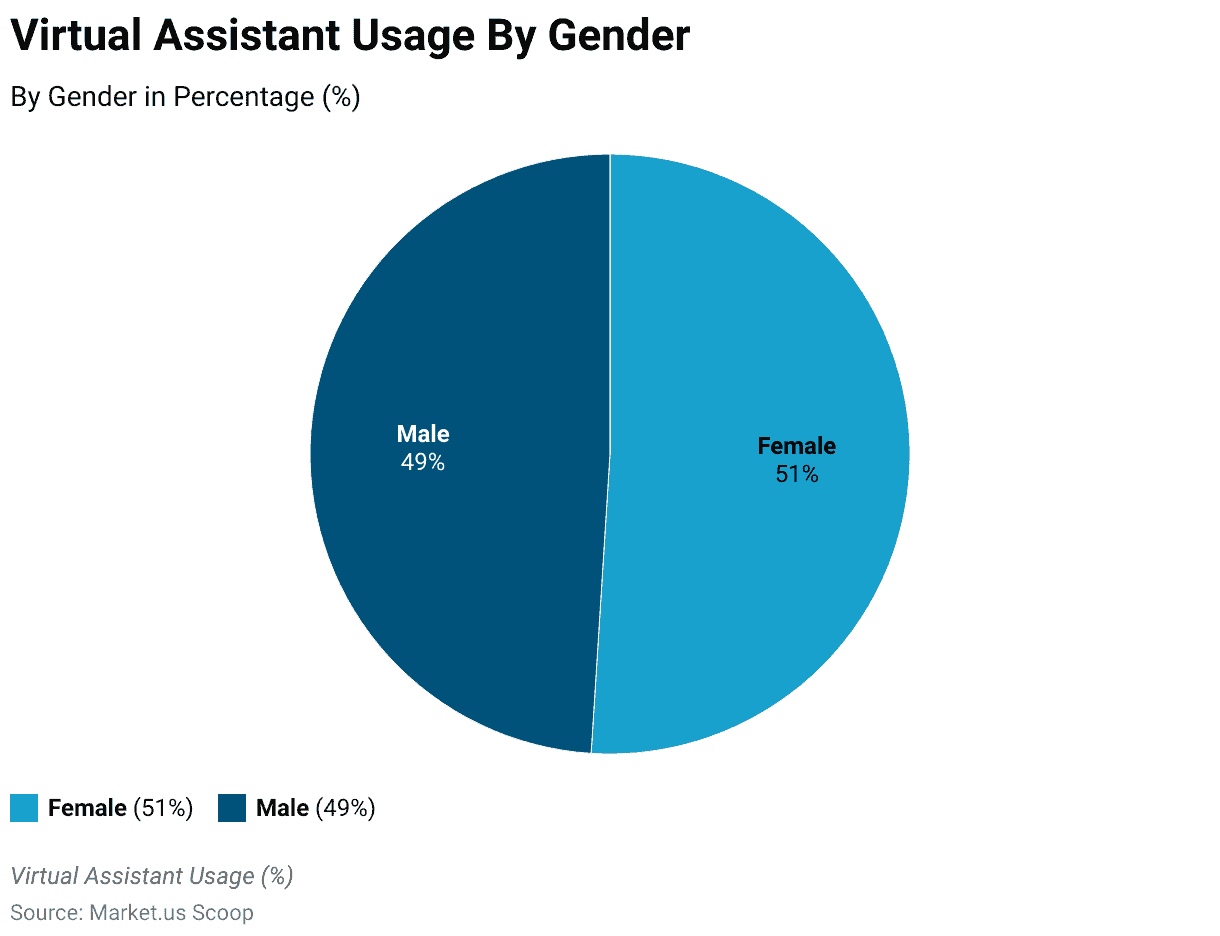
According to Age
- Virtual assistant usage spans various age groups, revealing distinct patterns of adoption. Among individuals aged 18 to 29, 28% actively employ virtual assistants, showcasing their prevalence among younger demographics.
- Similarly, in the 30 to 39-year bracket, 32% of respondents engage with virtual assistants, indicating a continued usage trend.
- Meanwhile, the 40 to 49-year age group and those aged 50 and above exhibit equal usage levels at 20%, suggesting a consistent appeal that transcends generational divides.
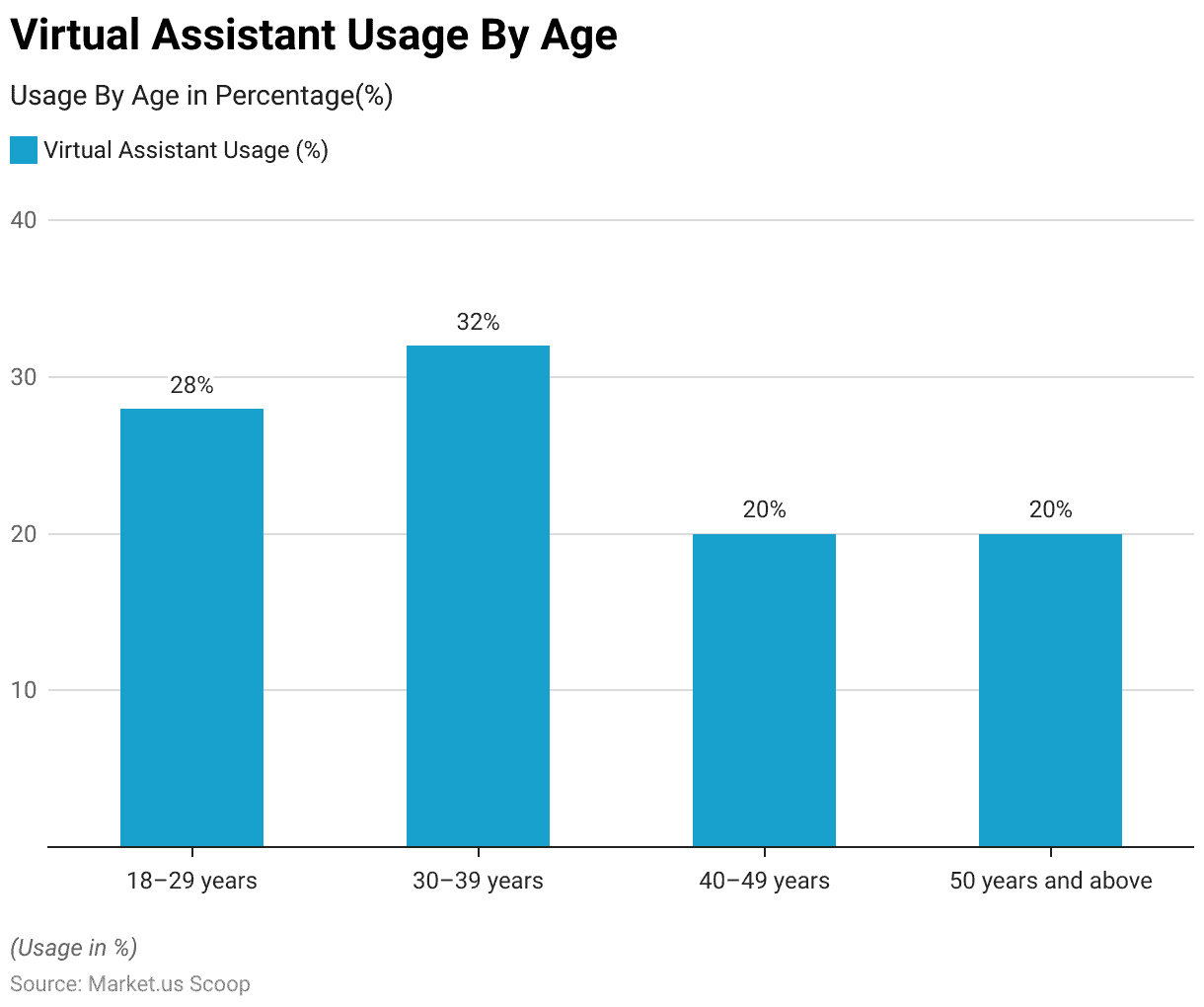
According to Academic Qualification
- Virtual assistant usage correlates with varying academic qualifications, reflecting nuanced preferences across educational backgrounds. Respondents with a high school diploma represent 17% of virtual assistant users, showcasing their engagement among individuals with foundational education.
- Of those holding a bachelor’s degree, 29% actively utilize virtual assistants, indicating a higher propensity for adoption among this cohort.
- Virtual assistant usage remains prominent even among individuals with higher academic attainments; 23% of those with master’s degrees engage with these tools, while 12% of respondents possessing a Ph.D. or higher qualifications also partake in their usage.
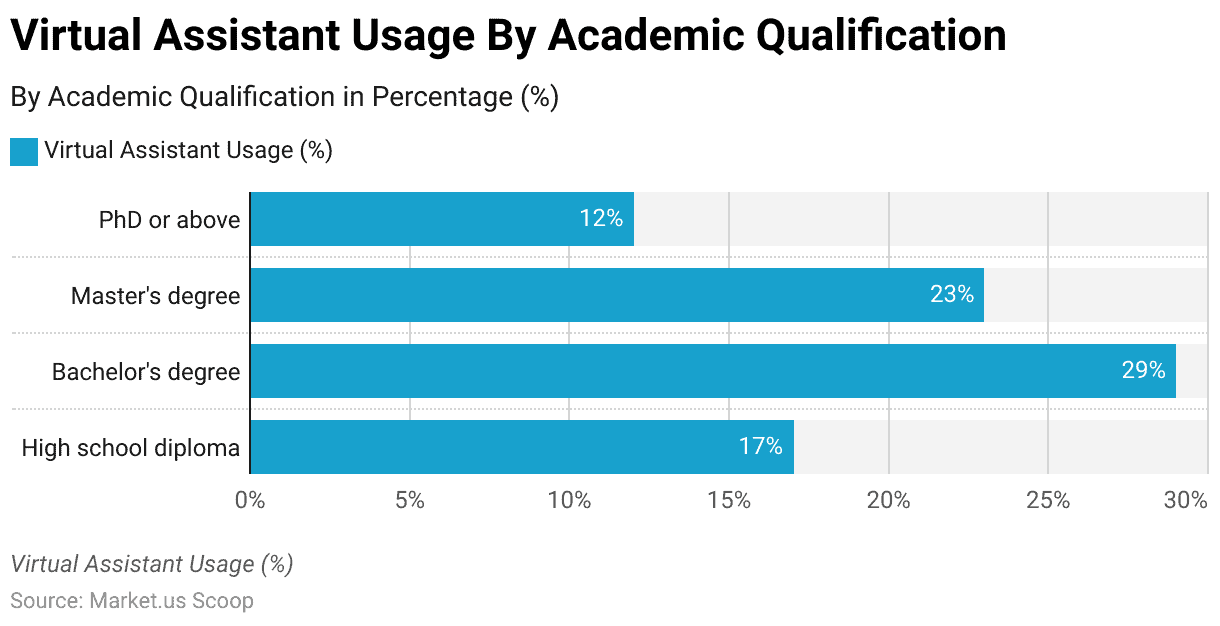
Major Virtual Assistant Players
Amazon Alexa
- As of the most recent data, around 68.2% of smart speaker users within the United States opt for Amazon Echo, an Amazon device powered by the virtual assistant Alexa. This percentage indicates a slight reduction of 1.5% from the figures recorded in 2020.
- Amazon Alexa achieved the top position in the global smart speaker market in 2019, commanding a share exceeding 21.7% of the total global smart speaker market.
- In a testament to its expanding ecosystem, Amazon Alexa facilitated compatibility with over 100,000 smart home devices, marking an impressive growth of about 40% compared to the 60,000 supported devices in 2019.
Apple Siri
- Apple asserts that Siri is being utilized by 500 million individuals globally; however, the frequency of usage, whether daily or monthly, remains undefined.
- Apple also states that 98% of smartphone users have experimented with Siri, yet not all consistently incorporate it into their routines.
- As of March 2017, among adults in the United States, 9% of respondents utilized Apple Siri on multiple occasions throughout the day.
- A combined 65% of those surveyed did not use the virtual assistant.
Google Assistant
- At present, Google Assistant holds the forefront position with a market share of 46%, and it is projected to substantially widen this lead by the year 2022, surpassing the 60% mark.
- The total count of Google Assistant apps steadily rose over several months. In April 2017, the
- The most significant leap occurred by January 2018, reaching a total count of 1,719 Google Assistant apps.
- In 2022, the landscape of voice assistants was already bustling with activity as millions of users engaged with these innovative technologies. Google Assistant boasted a user base of 81.5 million, while Siri, Apple’s renowned voice assistant, commanded a substantial user count of 77.6 million. Not far behind, Alexa, the voice assistant developed by Amazon, was embraced by 71.6 million users.
- Fast forward to 2024, and the growth trajectory of these voice assistants remains evident. Google Assistant’s user base swelled to 88.8 million, showcasing a continued preference for its capabilities.
Virtual Assistants Employment Statistics
- The year 2020 saw a notable 41% surge in the recruitment of virtual assistants through offshore agencies.
- Among these virtual assistants, 59% held full-time employment positions. While the traditional 9 to 5 office workday remains prevalent in numerous companies, many businesses embrace remote work policies.
- Statistical data concerning virtual assistants underscores that 85% of remote workers reported heightened productivity while working from their homes.
- The Philippines stands out as the favored destination for hiring virtual assistants, primarily due to its cost-effective average monthly rate of $400, which most Americans perceive as budget-friendly. On the contrary, the virtual assistant industry statistics indicate that professionals in the United States engaged in this field earn as much as $4,000 per month.
Discuss your needs with our analyst
Please share your requirements with more details so our analyst can check if they can solve your problem(s)



